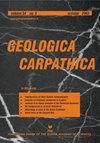奥地利北部波西米亚岩基南部Weinsberg花岗岩的对岩浆绿辉岩成因
IF 1.5
4区 地球科学
Q4 GEOSCIENCES, MULTIDISCIPLINARY
引用次数: 0
摘要
Weinsberg花岗岩是一种粗粒黑云母花岗岩,具有丰富的钾长石巨晶,是波希米亚地块摩尔多瑙河带晚瓦里斯坎摩尔多瑙河基岩中体积占主导地位和最具特色的花岗岩类型。在西部岩基区,发现了温斯伯格花岗岩的一种局部含正辉石岩变种(charnockite),前人将其命名为Sarleinsbach石英-二黄长岩。对其附近的绿硝子岩和相对基性较强的温斯伯格花岗岩进行全岩分析,发现其主量元素和微量元素在地球化学上均无显著差异。除绿砂砾岩中存在正辉石±斜辉石外,绿砂砾岩及其周围花岗岩的矿物学和岩石学基本相同。此外,绿帘石的特点是存在深灰色的玻璃状正长石巨晶,只有部分转化为微斜晶,而花岗岩中的钾长石巨晶则由白色微斜晶组成。绿辉石(正辉石、斜辉石、角闪石和黑云母)中的Fe- mg硅酸盐相对富铁(X Fe = 0.6 ~ 0.7),而斜长石中的钠长石(X Ab = 0.6)比斜长石中的钠长石多。研究了花岗岩及其伴生绿帘岩的流体包裹体,并对结果进行了比较。得出的基本结论是,形成花岗岩的岩浆主要是一种含cacl2成分的富h2o流体。形成绿硝石的岩浆主要是一种含少量NaCl成分的富CO 2流体,它使h2o活度降低到1以下,从而使正辉石±斜辉石在结晶过程中成为稳定的Fe-Mg硅酸盐相,而不是花岗岩中的黑云母。考虑到在整个地壳的P-T范围内,NaCl和cacl2存在时,富co2流体和富h2o流体是不混溶的,这意味着在花岗岩类熔体中,如果有co2存在,就会有以co2为主的区域和以h2o为主的区域,这两个区域的程度将由熔体中总的co2 / h2o比值决定。在CO 2占主导地位的区域,h2o活性可以充分降低,使正辉石在结晶过程中成为稳定的Fe - Mg硅酸盐相,尽管这也取决于这些相的Fe/Mg比和熔体的整体岩石化学性质。除了在印度南部和其他地方的太古宙地质体中常见的早期固态炭屑化外,这表明,如果原始岩浆中CO 2的含量超过一定比例,那么世界范围内的某些花岗岩和花岗岩类应该具有斑块和/或有限区域的炭屑岩。本文章由计算机程序翻译,如有差异,请以英文原文为准。
Genesis of a synmagmatic charnockite associated with the Weinsberg granite, southern Bohemian Batholith, northern Austria
: The Weinsberg granite, a coarse-grained biotite granite with abundant K-feldspar megacrystals, is the volumetrically dominant and most characteristic granite type of the late-Variscan Moldanubian Batholith in the Moldanubian zone of the Bohemian Massif. In the western batholith area, a local orthopyroxene-bearing variant (charnockite) of the Weinsberg granite has been identified and given the name of the Sarleinsbach quartz-monzodiorite in previous studies. Whole rock analysis of the charnockite and the relatively mafic Weinsberg granite in the immediate neighbor-hood show no significant geochemical differences with respect to either the major or trace elements. The mineralogy and petrology of the charnockite and surrounding granite are the same except for the presence of orthopyroxene ± clino - pyroxene in the charnockite. In addition, the charnockite is characterized by the presence of dark grey, glassy orthoclase megacrysts with only some partial conversion to microcline, whereas in the granite the K-feldspar megacrysts consist of white microcline. The Fe–Mg silicates in the charnockite (orthopyroxene, clinopyroxene, amphibole, and biotite) are relatively Fe-rich (X Fe = 0.6–0.7) whereas the plagioclase is more albitic (X Ab = 0.6) than anorthitic. Fluid inclusions from the granite and associated charnockite are investigated and the results compared. The basic conclusion is that the magma responsible for the granite was dominated by an H 2 O-rich fluid with a CaCl 2 component. The magma responsible for the charnockite was dominated by a CO 2 -rich fluid with a minor NaCl component, which lowered the H 2 O activity sufficiently below 1 such that orthopyroxene ± clinopyroxene was the stable Fe–Mg silicate phase during crystallization as opposed to the biotite in the granite. Taking into account that CO 2 -rich and H 2 O-rich fluids are immiscible in the presence of NaCl and CaCl 2 over the P–T range of the overall crust, the implication is that in granitoid melts, if CO 2 is present, there will be regions dominated by CO 2 and regions dominated by H 2 O. The extent of either region will be determined by the overall CO 2 /H 2 O ratio in the melt. In the CO 2 -dominated regions, the H 2 O activity could be sufficiently lowered such that orthopyroxene is the stable Fe–Mg silicate phase during crystallization, though this will also be dependent on the Fe/Mg ratio of these phases and the overall whole rock chemistry of the melt. In addition to incipient solid state charnockitization, commonly seen in the Archean terranes of southern India and elsewhere, this suggests that a certain subset of granites and granitoids worldwide should have patches and/or limited areas of charnockite if the amount of CO 2 present in the original magma goes above a certain fraction.
求助全文
通过发布文献求助,成功后即可免费获取论文全文。
去求助
来源期刊

Geologica Carpathica
地学-地球科学综合
CiteScore
2.40
自引率
23.10%
发文量
26
审稿时长
>12 weeks
期刊介绍:
GEOLOGICA CARPATHICA covers a wide spectrum of geological disciplines including geodynamics, tectonics and structural geology, volcanology, stratigraphy, geochronology and isotopic geology, karstology, geochemistry, mineralogy, petrology, lithology and sedimentology, paleogeography, paleoecology, paleobiology and paleontology, paleomagnetism, magnetostratigraphy and other branches of applied geophysics, economic and environmental geology, experimental and theoretical geoscientific studies. Geologica Carpathica , with its 60 year old tradition, presents high-quality research papers devoted to all aspects not only of the Alpine-Carpathian-Balkanian geoscience but also with adjacent regions originated from the Mediterranean Tethys and its continental foreland. Geologica Carpathica is an Official Journal of the Carpathian-Balkan Geological Association.
 求助内容:
求助内容: 应助结果提醒方式:
应助结果提醒方式:


